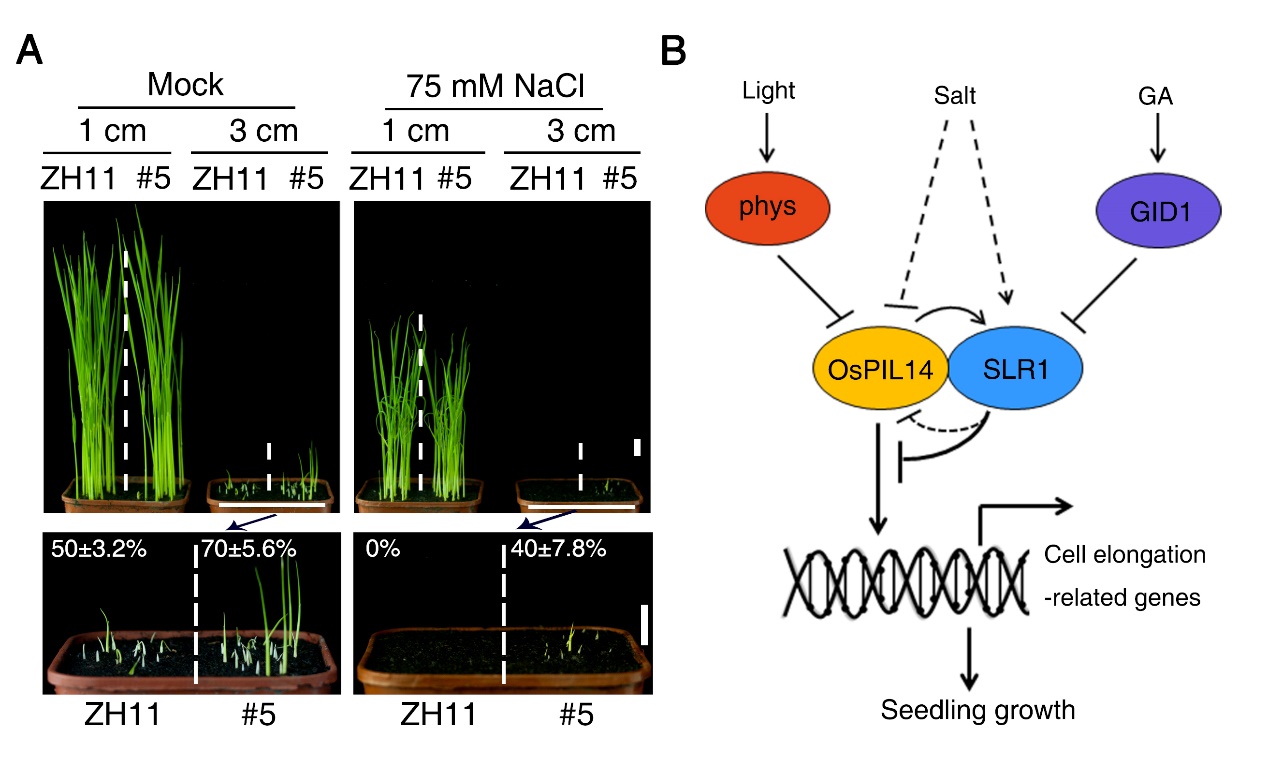Early seedling development and emergence from the soil, which are critical for plant growth and important for crop production, are controlled by internal factors, such as phytohormones, and external factors, such as light and salt. However, little is known about how light and salt signals are integrated with endogenous cues in controlling plant physiological processes.
A research group led by Professor Rongcheng Lin at the Institute of Botany, Chinese Academy of Sciences, has made progress in understanding the molecular mechanism of that the transcriptional module of OsPIL14-SLR1 integrates the light and gibberellic acid signaling pathways to control rice seedling growth under salt stress.
Six PHYTOCHROME-INTERACTING FACTOR-LIKE (PIL) genes, designated OsPIL11 to OsPIL16, were identified in the rice genome. Overexpression of six OsPILs genes promotes the mesocotyl elongation in darkness, in which OsPIL14 has the most obvious effects. The core inhibitor in gibberellin signaling, DELLA protein SLR1 interacts with OsPIL14, and inhibit the transcriptional activities of OsPIL14 in regulating the downstream cell elongation genes. Consistently, loss of function of the SLR1 promotes mesocotyl and root growth specifically in the dark and under salt stress. Further studies found that salt treatment promotes the degradation of OsPIL14 protein and enhances the stability of SLR1 protein. This study reveals that OsPIL14-SLR1 interaction integrates light and gibberellin signals to precisely control seedling growth under salt stress. Overexpression of OsPIL14 enhances salt tolerance in darkness, and significantly increases the emergence rate of direct seeding under salt stress, providing a suitable target for crop genetic modification with enhanced salt tolerance.
This study has been published online in Plant Physiology, recently. It was supported by the National Key Research and Development Program of China, Ministry of Agriculture of China, and the Strategic Priority Research Program of the Chinese Academy of Sciences.

(A) Morphology of ZH11 and OsPIL14OE plants grown under soil with or without 75 mM NaCl. Seeds were covered with a 1- or 3-cm soil. The percentages of seedling emergence were shown. (B) A proposed working model of the OsPIL14 -SLR1 module in regulating the growth of rice seedling under salt stress. (By IBCAS)
Article link: DOI: https://doi.org/10.1104/pp.20.00024;
Contact: Email: rclin@ibcas.ac.cn
Institute of Botany, Chinese Academy of Sciences
Early seedling development and emergence from the soil, which are critical for plant growth and important for crop production, are controlled by internal factors, such as phytohormones, and external factors, such as light and salt. However, little is known about how light and salt signals are integrated with endogenous cues in controlling plant physiological processes.
A research group led by Professor Rongcheng Lin at the Institute of Botany, Chinese Academy of Sciences, has made progress in understanding the molecular mechanism of that the transcriptional module of OsPIL14-SLR1 integrates the light and gibberellic acid signaling pathways to control rice seedling growth under salt stress.
Six PHYTOCHROME-INTERACTING FACTOR-LIKE (PIL) genes, designated OsPIL11 to OsPIL16, were identified in the rice genome. Overexpression of six OsPILs genes promotes the mesocotyl elongation in darkness, in which OsPIL14 has the most obvious effects. The core inhibitor in gibberellin signaling, DELLA protein SLR1 interacts with OsPIL14, and inhibit the transcriptional activities of OsPIL14 in regulating the downstream cell elongation genes. Consistently, loss of function of the SLR1 promotes mesocotyl and root growth specifically in the dark and under salt stress. Further studies found that salt treatment promotes the degradation of OsPIL14 protein and enhances the stability of SLR1 protein. This study reveals that OsPIL14-SLR1 interaction integrates light and gibberellin signals to precisely control seedling growth under salt stress. Overexpression of OsPIL14 enhances salt tolerance in darkness, and significantly increases the emergence rate of direct seeding under salt stress, providing a suitable target for crop genetic modification with enhanced salt tolerance.
This study has been published online in Plant Physiology, recently. It was supported by the National Key Research and Development Program of China, Ministry of Agriculture of China, and the Strategic Priority Research Program of the Chinese Academy of Sciences.

(A) Morphology of ZH11 and OsPIL14OE plants grown under soil with or without 75 mM NaCl. Seeds were covered with a 1- or 3-cm soil. The percentages of seedling emergence were shown. (B) A proposed working model of the OsPIL14 -SLR1 module in regulating the growth of rice seedling under salt stress. (By IBCAS)
Article link: DOI: https://doi.org/10.1104/pp.20.00024;
Contact: Email: rclin@ibcas.ac.cn
Institute of Botany, Chinese Academy of Sciences
